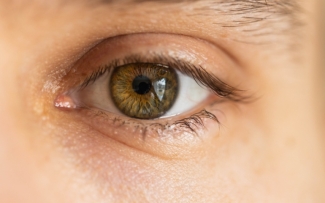Hazel eyes
Often described as a mesmerizing blend of green, brown, and gold, hazel eyes have a stunning appearance that can change with lighting and surroundings. In this blog, we will explore the details behind this unique eye colour, the science behind it, and give examples of celebrities with hazel-coloured eyes.
What colours are in hazel eyes?
Hazel-coloured eyes are unique because they contain a blend of different hues. Unlike more uniform eye colours such as blue or brown, hazel eyes are typically a mix of:
- Brown – Often forming the base colour, this is usually the most prominent pigment in hazel eyes.
- Green – Green flecks or undertones are common in hazel-coloured eyes, contributing to their dimensional appearance.
- Gold or amber – Many people with this eye colour have specks of gold or amber, which reflect light, so their eyes often look as though they are shimmering.
Hazel eyes often change colour slightly depending on lighting and surroundings, appearing greener in some settings and more golden or brown in others. This variability adds to their beauty.
How rare is hazel eye colour?
Hazel eyes are relatively rare compared to other eye colours. While the exact percentage of the global population with this eye colour varies based on geographic location and ethnicity, it's estimated that only about 5% of the world’s population has hazel-coloured eyes.
This uncommonness can make hazel eyes particularly memorable. In comparison:
- Brown eyes are the most common globally, making up around 70% to 80% of the world’s population.
- Blue eyes are seen in roughly 8% to 10% of the population.
- Green eyes are the rarest, accounting for only about 2%.
Hazel eyes are often mistaken for green eyes due to their shared colour patterns, but their distinct combination of brown, green, and amber makes them stand out.
What causes hazel eyes?
Eye colour is influenced by the amount, type, and distribution of melanin in the iris (the coloured part of your eyes) and the way light scatters through it. The iris has two layers: a front and a back layer. Unless you have a condition that affects melanin production, such as albinism, your irises will typically have some level of melanin in their back layer.
The melanin concentration in the front layer of the iris is what determines your eye colour. Hazel-coloured eyes have a level of melanin that falls between brown eyes, which have high melanin content, and blue eyes, which have little to no melanin.
Hazel eye colour can appear in many different ways. This has to do with the amount of two different types of melanin:
- Eumelanin controls the depth or darkness of pigment. A high concentration of eumelanin results in dark brown eyes, whereas small amounts result in lighter-coloured eyes like blue or green.
- Pheomelanin provides warm pigments, such as yellow or red.
The levels of eumelanin and pheomelanin are reflected in hazel eyes. Shades of hazel that appear more brown have higher levels of eumelanin, while hazel shades that appear more green have lower levels of eumelanin. People with hazel eyes that appear more golden or amber have higher levels of pheomelanin.
Genetics impact how much of each type of melanin is present in the iris as well as the skin and hair. Scientists have pinpointed multiple genes that work together to determine eye colour. However, two genes carry the most influence: OCA2 and HERC2.
Celebrities with hazel eyes
Many celebrities are known for their stunning hazel-coloured eyes, which often add to their overall appeal. Here are a few famous faces that proudly display this rare and beautiful eye colour:
- David Beckham
- Rachel Weisz
- Christian Bale
- Kate Beckinsale
- Hugh Jackman
- Karen Gillan
Hazel-coloured eyes are a stunning and rare blend of hues. Their uniqueness, coupled with their changing appearance and genetic complexity, only adds to their beauty.
For those who don’t naturally have hazel eyes and would like to simulate their appearance, consider hazel-coloured contact lenses. Coloured contacts are a great way to temporarily alter your eye colour and can be made with your vision prescription or prescription-free.
Book an eye test to update your contact lens prescription, then browse our selection of coloured contacts to find the perfect option for you.
SOURCES
- The world's population by eye color. WorldAtlas. January 2023.
- Eye colors. Cleveland Clinic. March 2024.
- Skin pigmentation types, causes and treatment — a review. Molecules. June 2023.
- What causes hazel eyes? Vision Center. October 2024.
- Investigating the genetic architecture of eye colour in a Canadian cohort. iScience. June 2022.


